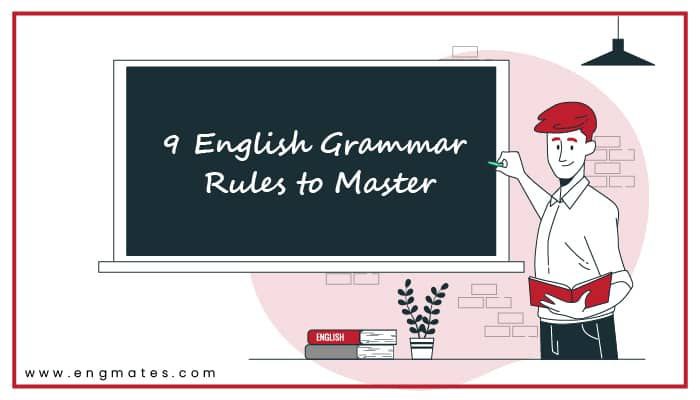
One of the most difficult aspects of learning any language is its grammar. English grammar is also among the most difficult frameworks out there. Compared to other languages, a small mistake in English grammar can change the meaning of the whole sentence.
Therefore, it is important to remember the essential English grammar rules. So, without further ado, let’s get into it:
Adjectives and Adverbs
Make sure you correctly employ adjectives and adverbs. Adjectives typically come before a noun and describe, identify, and quantify individuals or things. If the noun is plural, they remain the same. Adverbs typically follow the verb and are used to modify verbs, adjectives, and other adverbs. For instance:
He is a slow walker. (adjective)
He walks slowly. (adverb)
Preferred Written English and English Speaking Course in Delhi
Pay Attention to Homophones
Even though they are spelled differently, homophones are words that sound the same when spoken but have different meanings. This can undoubtedly lead to confusion, and sadly, English contains many of these words.
For example;
- They’re – their – there
- you’re – your
- it’s – it’s
- I – eye
- here – hair – hare
- break – brake
- flower – flour
- our – hour
So be sure to spell things correctly when you write. As you listen, keep in mind that a word you think you understand could actually mean something else.
Use the Correct Conjugations of the Verb
Don’t forget to align the verb with the subject. He, she, and it are the main subjects you need to be cautious with because they frequently take on a different form from the other subjects. For instance:
She has two dogs. RIGHT
She have two dogs. WRONG
Although it seems like a minor error, it is unfortunately quite obvious. Therefore, it will significantly affect how accurate you sound if you can avoid it.
Additionally, keep in mind that the verb must agree with the first thing you mention when describing something using the pronouns “there is” or “are.”
Read More- Why are some people better at speaking English than writing?
Use Conjugations Properly
You can use conjunctions to connect small sentences and short phrases. For example:
I work in XYZ. I like XYZ.
I am working in XYZ because I like it.
Some of the most common conjunctions are”
Because – to give a reason
But – to show contrast
And – to add more
So – to describe a consequence
Or – to show an alternative

Sentence formation
Sentences in written English are not that long. This means writing long sentences with complex words is not something you should think about while writing or speaking English. Usually, a sentence has two or three clauses (subject+verb+object) linked by a conjunction.
You can add commas to make your sentences clearer and easily understandable. Here are some of the recommended ways you can use commas:
- Between two clauses
- To make separations
- After some conjunctions.
- To add extra information in the middle of a sentence
Read More- What are Binomial Expressions: Definition with Examples
Remember the Order of Words to Form Question
In English, the question form differs from the affirmative form in structure. So be sure to either add the auxiliary “do” or remember to change the word order. In English, there are four ways to form a question:
- “To be” – Invert the subject and verb for questions that use the verb “to be.” For instance, do you attend school?
- All other verbs – add the auxiliary “do” to create questions for all other verbs. Are they employed here, for instance?
- Modal verbs: Invert the modal verb and the subject to form questions with modal verbs. Can he play the piano, for instance?
- Auxiliary verbs: Invert the auxiliary verb and the subject in sentences that use an auxiliary verb, such as “have” in the present perfect.
Use the Correct Past Forms
Speaking in English about the past is not particularly challenging. The past is expressed in every subject using the same word, so you don’t need to worry about learning six different words like in some languages. However, a lot of verbs are irregular and don’t always add a -ed. While not all of these are necessary, try to learn the most popular ones (approximately 20). For instance:
Go – went
Have – had
Make – made
Remember the Verb Tense
You won’t be familiar with all the tenses if you’re just starting to learn English. And it’s all right. Just concentrate on learning the four or five that are used the most. Attempt to be able to employ these.
- Present simple is used to describe routines and ongoing circumstances. For illustration, We reside in New York.
- Present continuous is used to describe both present circumstances and upcoming plans. I’m meeting John later, for instance.
- To describe completed past actions, use the past simple. For instance, They showed up at 3 p.m.
- To describe past events related to the present, use the present perfect tense. For instance, the reports have been completed.
- Will – used to indicate upcoming behavior. I’ll meet you, for instance, in front of the conference room.
Never Use Double Negative
There are frequently two ways to express a negative idea in English. For instance, you could state: “The room is empty.”
Nothing is present in the space. OR Nothing is present in the space.
The terms “nothing” and “anything,” while having the same meaning, are used with different types of verbs depending on their tenses.
The following words also fall under this rule:
Nobody – anyone
none — any
When discussing experience, the same is true of the word “never.” One may say:
He has never visited America. He has not ever been to the United States.
The second sentence’s use of the word “ever” changes the meaning slightly but retains the same meaning.
Conclusion
Although English grammar is somewhat challenging, once you master it, you’ll be able to speak and write more effectively. Use the appropriate verb tense, become familiar with the tenses, and avoid using double negatives at all costs are a few other essential English grammar rules to keep in mind.
If you liked this blog, you can try our Grammar practice exercises here.
